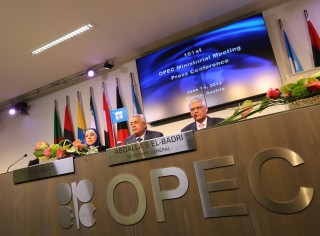Saudi Arabia, Russia, and other large oil producers are moving to negotiate a potential joint output cut to stem the present historic price crash, as the world continues to grapple with the fallout from the coronavirus crisis.
Crude prices have plunged 50 percent this year, on the back of the pandemic-triggered collapse of global demand by almost a third. But prices rose significantly last Thursday and were up again on Friday during early trading, after a tweet from U.S. President Donald Trump regarding a supposed 10-15 million barrels per day cut from Russia and Saudi Arabia.
Such a joint intervention would be the largest ever but the talks still face significant obstacles, experts say. A virtual meeting of producers from the OPEC+ coalition and other major producers in the world, initially scheduled for Monday, was postponed tentatively to Thursday, April 9 after tensions flared up between Saudi Arabia and Russia.
Riyadh had called for the emergency meeting but said that action on its part would depend on other countries participating. While Moscow said no conversations occurred and that it had not agreed to anything, reflecting a reluctance to cut output, while eyeing a decline in U.S. shale.
More so, both parties want the U.S. to join in the joint global production cut, but President Trump has so far shown little willingness to do so. “While the numbers in Trump’s tweet appeared unrealistic, there is some degree of interest from all sides to collective production cuts,” Oil price notes. “But it is not clear that the U.S. would offer anything” after reports surfaced that Washington “would not ask domestic oil producers to cut output.”
Oil diplomats meanwhile noted on Sunday that some progress had been made. They plan to hold a meeting of G20 energy ministers this Friday, in a bid to get the U.S. to cooperate in the cut, reports say.
And in other signs of progress, Norway, which has not joined any production cuts in nearly two decades, gave a hint it was ready to reduce its output if others did. Also, a senior official from Alberta, the oil-rich Canadian province, said it will dial into the oil meeting this week while Iraq’s oil minister expressed optimism about a deal.
OPEC meeting can’t save market
The ongoing oil price crash has threatened the stability of oil-dependent nations and could force some producers to suspend output as the world runs out of storage on land and at sea. But even deeper production cuts by the OPEC coalition and other major oil producers would still be unable to prevent an enormous global inventory build this quarter due to unprecedented demand destruction, the International Energy Agency has said.
Many countries have imposed a series of strict measures to curb the coronavirus pandemic which include restricted commuter travel and grounded flights. More than 3 billion people remain in lockdown and with them their everyday activities, resulting in a collapse of huge volumes of oil demand. Driven by the economic slowdown, demand for oil in April is expected to drop by 20 million bpd year on year, and probably more, experts say.
Fatih Birol, Executive Director of the IEA, which represents nations that consume oil, told Reuters that even if OPEC+ and other producers were to discuss, agree to, and implement a collective cut of 10 million barrels per day, global oil inventories would still rise by 15 million bpd in the second quarter.
Moreover, the oil price reaction would be minimal and very short-lived even though a Saudi-Russian combination would cut 10 million bpd, Cyril Widdershoven writes on Oilprice. “The ongoing oil market volatility, the battle between leading producers for market share, the logistical impossibility of enforcing U.S. production cuts, and the continued demand destruction caused by COVID-19 are not issues that can be solved by an OPEC meeting.”








